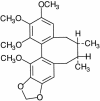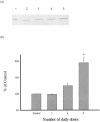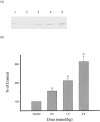Effects of schisandrin B pretreatment on tumor necrosis factor-alpha induced apoptosis and Hsp70 expression in mouse liver
- PMID: 11525242
- PMCID: PMC434382
- DOI: 10.1043/1355-8145(2001)006<0044:EOSBPO>2.0.CO;2
Effects of schisandrin B pretreatment on tumor necrosis factor-alpha induced apoptosis and Hsp70 expression in mouse liver
Abstract
Tumor necrosis factor-alpha (TNFalpha) could cause apoptosis in hepatic tissue of D-galactosamine sensitized mice, as evidenced by the increase in the extent of DNA fragmentation. The hepatic apoptosis induced by TNFalpha was associated with hepatocellular damage as assessed by plasma alanine aminotransferase activity. Schisandrin B (Sch B) pretreatment at daily doses ranging from 0.5 to 2 mmol/kg for 3 days caused a dose-dependent protection against TNFalpha-induced apoptosis in mice. The hepatoprotection was accompanied by a parallel reduction in the extent of hepatocellular damage. The same Sch B pretreatment regimens increased hepatic Hsp70 level in a dose-dependent manner. The relevance of Sch B-induced increase in Hsp70 expression to the prevention of TNFalpha-triggered hepatic apoptosis remains to be elucidated.
Figures




References
-
- Bonavida B. TNF as immunomodulatory agent. Immunol Ser. 1992;56:315–329. - PubMed
Publication types
MeSH terms
Substances
LinkOut - more resources
Full Text Sources
Other Literature Sources
Medical
Miscellaneous
